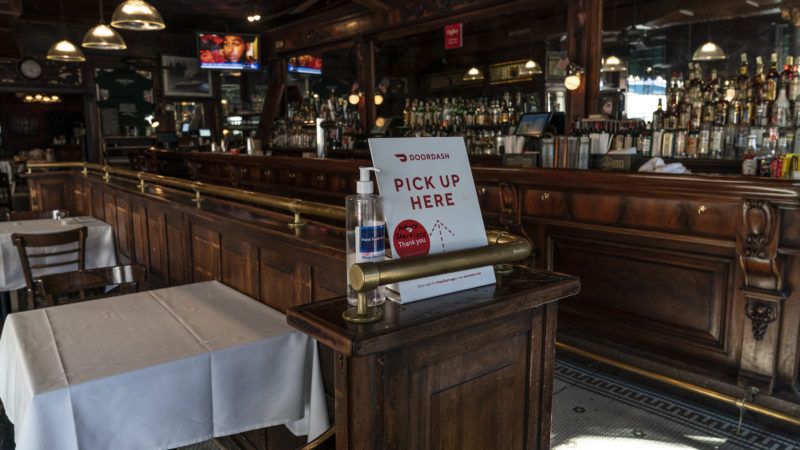Businesses Prepared for Natural Disasters Are Surviving COVID-19 Better Than the Competition
A government survey finds that prepping for hard times can have wide benefits.

In the early days of the pandemic, as toilet paper, flour, and other supplies disappeared from market shelves, rueful media stories acknowledged that preppers—who have been the butt of jokes and over-the-top reality shows—may be on to something after all. Being equipped to weather difficult times, it turns out, puts you ahead of the game when those difficult times arrive.
A recent federal report gives preppers perhaps more reason to feel a bit smug. Drawing on the results of a survey of over 1,300 small- and medium-sized enterprises across the country, it reveals that businesses that planned for and have dealt with natural disasters are surviving lockdowns and social distancing better than the competition.
"Nearly a quarter of businesses felt natural disaster preparations helped them address COVID-19," researchers from the National Institute of Standards and Technology (NIST) and the National Oceanic and Atmospheric Administration (NOAA) report of the results of the joint survey.
Two-thirds of surveyed businesses said that they had prepared for natural disasters. The reason why becomes clear given that a large majority of respondents—ranging from 74 percent in the West to 89 percent in the South—suffered natural disasters within the past 10 years. Such disasters included predictable chronic problems (as defined by the survey) such as drought, extreme cold, heat waves, winter storms, and flooding, as well as unpredictable acute events including hurricanes, storm surge, earthquakes, tsunamis, tornadoes, and wildfires.
In a year marked by hurricanes and wildfires in addition to COVID-19, a full 29 percent of surveyed businesses reported suffering from a natural disaster since the beginning of the pandemic.
Unsurprisingly, preparations that help businesses pull through the strictures and economic pressures of the pandemic are those that aren't completely targeted at events such as hurricanes or earthquakes. "Practices with broad applicability shone through over those specific to one kind of disaster. Two notable examples from the responses were having rainy-day funds for when income streams dry up and the ability to operate a business remotely."
Working with companies that would normally be rivals is also a common tactic. "Across the board, there are reported increases in cooperative actions with counterparts in the same industry and geographic location that would typically be market competition."
To a large extent, the NIST/NOAA survey results confirm with data the impressions of a flurry of earlier media takes on the unanticipated (in some circles) wisdom of preparing for hard times when things are good.
"For years, one of the most smirked-at subspecies in the technology ecosystem was that of the Silicon Valley Prepper," Nellie Bowles wrote for The New York Times in April as many Americans scrambled to find kitchen staples and cleaning supplies. "Now, with Covid-19, they feel vindicated. Because they are. The coders and founders long snickered at for stockpiling flour and toilet paper were absolutely right."
The worst panic-buying and shortages of the early days of the pandemic have since subsided. But some products remain in short or spotty supply. Lean manufacturing practices left cleaning-product companies slow to respond to an unexpected surge in demand. Some canned foods remain hard to find as a result of high demand and also because certain crops have one harvest per year that needs to last until the following season.
Anticipating new purchasing rushes in case of a second wave of COVID-19 (or election-related worries), grocery chains are stockpiling supplies for future sale. But they're relying on supply chains disrupted by regional conflicts around the world and then stressed—beyond the breaking point in places—by pandemic-related restrictions.
"This year, farmers and consumers have been planning production and managing household budgets at a time when markets—food, commodity, labor, energy—are being jolted by global, national and regional shutdowns, slowdowns, and overall uncertainty," Robert Johansson, the U.S. Department of Agriculture's chief economist, wrote this month. "Those shocks to the U.S. and global economies have affected both the supply and demand for food in the U.S. and the rest of the world, leading to short-term, localized shortages in the U.S." and "the impacts of COVID-19 are expected to continue into next year."
In September, the United Nations reiterated earlier warnings of the potential for a "global hunger crisis" and stressed the need for balance between COVID-19 containment measures and measures "to keep borders open and trade flows moving,"
So, being prepared for difficult times isn't becoming any less advisable.
That's not to say that preparing for disaster is the same thing as rendering yourself or your business disaster-proof.
The NIST/NOAA survey asked respondents how long it will be before they can return to pre-COVID-19 business capacity, getting 992 responses. Twenty percent said less than one year, 19 percent said 12 to 18 months, and 23 percent said more than 18 months, with 19 percent saying it will likely never happen.
Natural disaster preparations that help a small firm survive the absence of customers who choose to temporarily shelter at home or closure orders from a state government are of limited help if the market changes and a business model stops being viable. In that case, extra money in the bank and a resilient mind-set won't stop the fall—but they might cushion it. Part of preparations, then, should probably include readiness to close up shop and try something different.
There are also limits to resilience and the ability to create a cushion. Many respondents, including 90 percent of those who dealt with disasters in the past, agreed that "the impacts of COVID-19 will leave my organization unable to cope with a natural disaster, should one occur, in the next year."
There are no guarantees in life. But the data suggests that preparing during good times for possible challenges ahead can tilt the odds at least a little in our favor.
Show Comments (53)